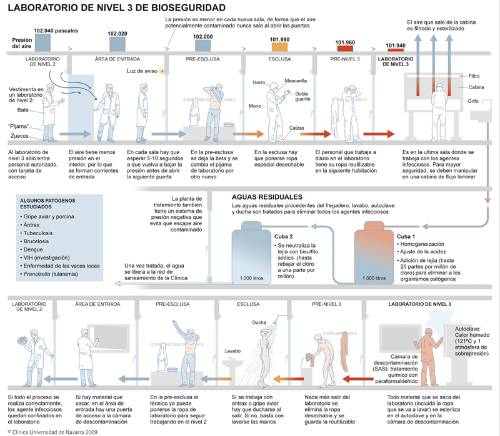Biosafety Laboratory
Level 3 (BL3)
The Clinic has a biosecurity level 3 (BL3) laboratory, which allows the handling of biological agents that cause infectious diseases potentially lethal to humans.
Within the biological safety measures required in this type of facility, the Clinical Microbiology Service's BL3 laboratory has been designed in accordance with Canadian legislation, one of the most advanced and safest in the world, and the World Health Organization (WHO) guidelines.
Some of the microorganisms that are processed in BL3 laboratories are those that cause avian flu, anthrax, tuberculosis, Malta fever, dengue, HIV or mad cow disease.
Learn about the Biosafety Laboratory and its work
Biological agents are classified into four groups according to the risk of infection:
- Group 1 biological agent: one that is unlikely to cause disease in humans.
- Group 2 biological agent: that which can cause a disease in man and can pose a danger to workers, being unlikely to spread to the community and generally existing prophylactic (preventive) treatment or effective treatment. For example, agents that cause meningitis, salmonellosis, etc.
- Group 3 biological agent: that which can cause a serious illness in man and presents a serious danger to workers. In this case there is a risk that it may spread to the community and there is generally a prophylactic (preventive) treatment or an effective treatment. For example, agents that cause anthrax, tuberculosis, dengue fever, etc.
- Group 4 biological agent: that which can cause serious illness in humans and poses a serious danger to workers. There is a high probability that it will spread to the community and in this case, there is generally no preventive treatment or effective treatment. For example, the Ebola virus.

The activity of the laboratory is focused on the detection of group 3 biological agents (according to RD 664/97) in clinical samples, mainly through isolation, culture and subsequent identification and study of sensitivity to anti-infective agents, which will establish the treatment of the infectious disease.
In addition, the detection of specific components (nucleic acids, proteins, etc.) of the biological agents causing the infectious diseases is carried out.
The BL3 laboratory is also used for the management of biological agents under investigation and which can be a risk for the researcher (agent of legionellosis and multiresistant bacteria to antibiotics).

The facilities consist of four independent compartments (airlocks) that must be passed through before reaching the laboratory. The five spaces have negative pressure (the atmospheric pressure inside is lower than the atmospheric pressure outside) so that the air only circulates inside the laboratory and never leaves.
The passage from one airlock to another is done through a door locking system to maintain the negative pressure. This is an interlocking mechanism whereby the door of each compartment does not open until the previous one has been closed and the set vacuum level has been reached.
Laboratory workers must be fully equipped with personal protective equipment: gloves, mask, goggles, disposable coverall, etc. to guarantee total isolation from microorganisms.
The facilities have a ventilation system with HEPA filters for impulsion and extraction.
Sample processing is carried out in a biological safety cabinet that protects workers and allows samples to be handled in a contamination-free environment.

Access
Access is restricted by ID card and to qualified personnel. These personnel must have specific training and a medical certificate of aptitude. The laboratory has alarm systems, intercom and surveillance cameras.
Protection equipment
Personal protective equipment consists of coveralls, gloves, tights, safety goggles and a highly efficient mask (FFP 3).
Disposal of waste
All material to be removed from the laboratory is subjected to two decontamination processes: autoclave and double-door chemical decontamination chamber (SAS-Sterilized Air System). Effluent (liquid) treatment is not required for a BL3 level, although it is mandatory for the BL4 level. The Clinic's biosafety laboratory has a drainage system with a waste treatment plant. It consists of a control room and the waste treatment room itself. The latter is considered a level 3 biosafety laboratory (BL3).

